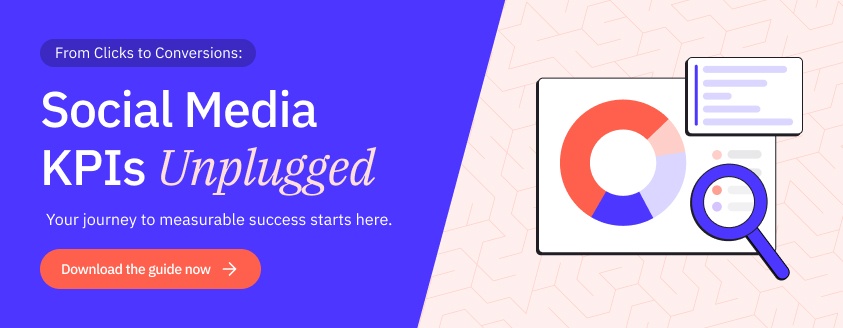Social media has become an integral part of our daily lives, personally and professionally. It’s changed how we connect, communicate, learn, and shop. But if we’re really honest, it’s changed everything about how we live.
But has it changed the way you do your marketing?
Over 62% of the world is on social media each day. There’s a pretty good chance your target audience is spending time there. Are you using social media to reach them?
Social media management is essential for building your brand, engaging customers, and driving business growth.
This comprehensive guide will teach you everything you need to know about social media management, from understanding its significance to mastering its key components.
Here’s what we’ll cover:
- What is social media management?
- What is the role of a social media manager?
- Why is social media management important?
- 8 components of social media management
Let’s dive in.
What is social media management?
Social media management is the process of creating content, analysing metrics, and engaging with followers on social media platforms. It includes various activities to build and maintain a brand’s online identity.
However, social media management is about much more than producing content. It's about building a community around your company to increase brand awareness and loyalty.
Social media management involves identifying target audiences, determining the appropriate platforms for engagement, and developing content that resonates with followers.
It also includes tedious tasks like monitoring platforms for mentions, comments, and messages.
Alongside content creation and audience engagement, social media management involves tracking and analysing performance metrics to measure the effectiveness of social media efforts.
This data-driven approach enables businesses to refine their strategies, optimise content, and achieve better outcomes.
Doesn’t that seem like a lot of responsibility?
Social media management can feel daunting. Some businesses know this and have a social media manager or an entire team overseeing these activities.
Other companies may outsource the work to freelancers or social media marketing agencies. We’ll cover the role of a social media manager in the next section.
Whether you’re a startup, an established small business, or somewhere in between, social media management can enhance your brand’s reputation and build meaningful connections with your target audience.
What is the role of a social media manager?
A social media manager is more than just someone who scrolls through Facebook or TikTok for you and collects a paycheck.
They’re responsible for meeting the company’s strategic objectives through social platforms.
From crafting engaging content to managing social media accounts to monitoring interactions, a social media manager plays a crucial role in businesses leveraging social media to meet their marketing goals.
Being successful in this role requires a unique blend of skills. An excellent social media manager should be organised, adaptable, creative, curious, and strategic.
A social media manager is a brand ambassador for your company. They should also have a robust understanding of the company’s vision, mission, origin, tone, style, etc.
That begs the question: do you need to hire one?
Before you rush to post a new job opening, here are several questions to ask yourself.
These will help you evaluate your current social media presence and objectives to determine whether hiring a social media manager is the right move.
- Current activity: Does your business's target audience spend time on social media? If yes, which platforms? Facebook? Instagram? X? TikTok? How active is your company on social media right now? Do you regularly post content and engage with your audience? (If no, why?)
- Strategic goals: What are your company's marketing objectives? How do they align with your social media goals? Are you looking to increase brand awareness, drive sales, or improve customer service through social media?
- Resource allocation: Do you have the time and expertise to manage your social profiles, or is there someone already on your team who does? Would hiring a dedicated person free up resources and enhance the quality of your social media activities?
- Competition: How are your competitors using social media? Is there something you can learn from them? Is social media where you can get a leg up on them? If so, how?
If you need more time to maintain a consistent social media presence, lack the expertise to develop effective strategies, or simply need more time and energy to do it effectively, it might be time to hire a social media manager.
Whether you hire someone or go at it yourself, Sendible’s all-in-one social media platform can help with organisation and efficiency with features like its content library management that allow users to save content on the go that they can then work on later.
Sendible provides a seamless experience for scheduling, monitoring, and reporting from all your social media accounts in one place. Try it today for free.
Why is social media management important?
As brand ambassadors, social media managers and content creators play pivotal roles in your business.
Their job is to craft timely, relevant content that appeals to your audience day after day. Since they also engage with followers through comments and DMs, they play the crucial role of customer manager.
These activities are what social media management is all about. Let’s break down what social media management does for your business:
- Brand visibility: Maintaining an active presence on social media showcases your brand. Your current customers will become more loyal, and you’ll expand your reach to new audiences. With the average user spending almost two and a half hours on social media each day, it’s like people are just lining up to get connected to your brand.
- Audience engagement: Social media lets you engage with your audience in real time. It’s also informal communication, so customers are less likely to feel pressured or intimidated. Engaging content, timely responses to comments and messages, and meaningful conversations help build stronger relationships with customers.
- Reputation management: Social media plays a significant role in shaping your reputation. Effective social media management involves monitoring brand mentions, addressing customer feedback, and managing crises promptly to maintain a positive brand image.
- Driving website traffic: Social media platforms will likely become your top website referrer. Sharing clickable content will drive more traffic to your site, get more conversations, and generate leads to grow your business. The best part? Your social media business accounts are free. While you can use paid social media ads (see below), writing a blog and referring followers to it from your social accounts costs you nothing.
- Competitive advantage: You can gain an edge by excelling in social media management. Depending on your industry, a solid social media strategy can set you apart in a crowded marketplace. The craziest thing? This can happen even if you aren’t an industry leader or the most prominent business.
- Data-driven insights: Social media analytics provide valuable insights into audience behaviour, preferences, and trends. Knowledge is power, right? The more data you have, the better your chances of making better, more informed decisions about your marketing strategies.
Social media management isn’t optional. It needs to be a centrepiece of your marketing strategy. If you want to build and maintain a solid online presence, build customer loyalty, and generate more leads, social media is the pathway to get there.
8 components of social media management
We’ve covered the basics of social media management. Now, let’s dig into the eight things you need to get right to succeed.
1. Choose the right platforms
Not every social media platform is right for every business. Before creating content, choose the platforms where your target audience is most active and engaged.
Consider your audience's demographics and interests when deciding which platforms to use.
For example, platforms like Instagram and TikTok may be more suitable if your brand appeals to a younger demographic. Facebook or LinkedIn might be better for reaching an older demographic, professionals, and B2B audiences.
Next, think about the type of content you want to share and the format that works best for your audience.
Visual content thrives on platforms like Instagram or Pinterest. TikTok is perfect for snackable videos. Twitter/X is ideal for short, text-based updates and news but not visual media.
The Washington Post is one of the largest newspapers in the United States. They do serious journalism but use TikTok for funny videos and even behind-the-scenes skits.
The paper doesn’t put these videos on other platforms where followers typically go for actual news.
Once you've identified the platforms that align with your audience and content strategy, invest your resources into building a strong presence on those platforms.
Consistency is key! Post regularly and engage with your audience to keep up your momentum. The more active you are in comments, replies, and DMs, the more active your followers will become.
Choosing the right platforms will help you tailor your approach to fit your audience's preferences.
This will maximise the impact of your content creation and save precious time and energy.
2. Use social media management tools
It’s evident that managing multiple social media platforms at once can be overwhelming. You don’t have to do it manually.
Selecting the appropriate social media management tools can significantly enhance the efficiency and effectiveness of your social media efforts.
Many social media management tools offer various features to streamline scheduling, conversation monitoring, and performance analysis.
How do you choose the right social media management tool?
Consider these factors:
- Your budget
- Number of profiles you manage
- Analytics gathering
- Scheduling capabilities
- Integrations with other software
Just like with any product, check out customer reviews, seek recommendations for colleagues, and use free trials to help you make an informed decision.
Thankfully, Sendible checks all the boxes and offers solutions for every social media platform on the market.

3. Optimise your social media profiles
Your next step is to optimise your profile for maximum visibility and engagement. Here’s a list of five things to optimise your social media profile
Complete your profile
Ensure your profile has all the necessary information, including your bio, website link, contact details, and profile picture. A completed profile produces trust and credibility with your audience.
Use keywords in your bio
Incorporate relevant keywords into your bio and profile description. This helps people find you on the platform.
What terms could your audience use to find businesses like yours? Use those words in your bio.
Of course, you don’t need to use every possible keyword. If you help people find jobs, strategically include one or two of them in your description, like “remote work” and “career advice.”
Get Verified
Social media verification allows you to show that your account is authentic.
It shows your brand is real and not run by a bot or someone imitating your identity. Most social media platforms display a “Verified” badge, checkmark, or another indicator that you are a verified account.
If you’re able to get verified, do it. It builds confidence with your audience.
Consistent branding
Maintain consistent branding across all your social media profiles, including profile pictures, cover photos, logo use, and colours.
Consistency helps reinforce brand recognition and creates a cohesive brand identity. We’ll discuss maintaining your brand voice more fully in #7 below.
Include CTA links
Encourage followers to take action with a clear CTA in your profile bio. That could be a link to your website, newsletter, or a link-in-bio solution like LinkTree, Linkin.bio, or others.
A link-in-bio solution is perfect when you don’t know which link to share or if you have several possible destinations.
4. Create and curate content
Creating and curating compelling content is at the heart of successful social media management. As the saying goes, “Content is king!” And it’s true. Two tactics will help you do this.
First, you need to develop develop a content strategy plan. You don’t know what you're shooting for without a well-defined strategy.
Start by identifying your target audience and setting clear objectives for what you want to accomplish.
Then, outline the types of content you'll create and the themes or topics you want to cover.
Be sure to consider the platforms you'll use and tailor your content strategy to fit the preferences of each platform's audience.
Second, use a content creation calendar to stay organised and consistent with your posting schedule.
Plan your content in advance, scheduling posts for optimal times and ensuring a diverse mix of content types. Using a calendar will help you plan ahead for special events and holidays, like this Christmas post from Starbucks.
Use a social media planner to help with your strategic planning and calendar. By developing a content strategy plan and using a content creation calendar, you’ll deliver valuable content to your audience at the right time of year.
5. Get social in the online community
Social media is designed to be, well, social. So don’t just click “post” and forget about it. Engage with your audience.
Monitor the activity in your industry and jump into meaningful conversations. Collaborate with the right partners.
To do this well, you want to practice what’s called “social listening.”
That’s just a fancy way of saying you want to pay attention to what’s being said about your brand online.
How do you do this?
Make sure your social media accounts have notifications turned on for the following:
- Reactions: Someone reacted (e.g., “Liked,” shared, etc. ) to your post or comment.
- Comments: Someone commented on your post or on another comment you made.
- Replies: Someone replied to your post or comment.
- Tags: Someone tagged your account name (@handle) in a post or comment.
- Direct messages: Someone sent you a private message.
When you’re keeping pace with this activity, it will keep you busy engaging with followers. But it will be worth in the long run.
People will know that you are a real company and person behind your profile, which will produce loyalty on their part.
6. Extend your reach with paid ads
While organic reach is valuable, running paid ads on social media platforms can significantly expand your reach to a broader audience.
You don’t need a huge budget to do it, either. Just a couple of bucks a day can make a huge difference.
Native advertising is the most common approach to social media ads. This is when you create a regular post and pay to get more eyeballs on it. It’s called a “sponsored” post on Facebook, Instagram, and LinkedIn.

On Twitter/X, these are simply called an “ad.”

Native ads are great for building your audience, but you can branch out into other ads as you grow.
On YouTube, you can run pre-roll ads, which are basically like commercials before a user watches their desired content.
LinkedIn allows you to send sponsored messages to potential clients. These come to the client via “InMail,” LinkedIn’s messaging service.
Nearly all of these social media ads are on a PPC (pay-per-click) basis. This means you pay only when someone clicks on your ad.
You get to set the budget so you never overspend. PPC ads are one of the cheapest and most practical forms of advertising you can find.
7. Maintain your brand voice
A major aspect of social media management is the ability to communicate who you are and what you do consistently. You’ll never build trust and recognition with users online without a consistent brand voice.
At first thought, this might seem like second nature.
But if you don’t pay attention to how you post or have someone solely devoted to it (like a social media manager), your brand voice can slowly evolve into something it was never meant to be.
Follow these tips to maintain a cohesive brand voice across all your channels.
- Define your voice: Determine the tone, style, and language that best represents your brand identity and resonates with your audience. If it’s “fun, professional, intelligent,” then one or all of those descriptors should be represented in every post.
- Create brand guidelines: Establish clear guidelines outlining your brand voice, tone, and style, and share them with content creators to ensure consistency. (Pro tip: this is something that every business should have regardless of whether or not they use social media.)
- Be authentic: Stay true to your brand personality, core values, etc., in all communication to build genuine connections with your audience. You may be tempted to post or share something that contradicts who you are. Don’t do it! Ever.
- Tailor your voice: Adapt your messaging to fit the nuances of each social media platform while maintaining consistency in tone and style. For example, you can get away with more humour on Instagram or TikTok than on LinkedIn (example: see The Washington Post above!).
- Monitor and adapt: Regularly monitor feedback and engagement metrics to gauge audience perception and adapt your brand voice as needed.
Maintaining a consistent brand voice across social media channels strengthens brand identity, fosters trust, and creates a cohesive brand experience for your followers.
8. Monitor your results with analytics
This is probably the most significant component of social media management. If you do everything else we mentioned but not this, it’s all for nought.
You will have wasted your time.
Tracking and analysing performance metrics is essential for measuring the effectiveness of your social media efforts.
It also empowers you to implement changes to your strategy for better results.
How can you know which metrics to track in each platform? We’ve got you covered:
- Facebook: Reach/impressions, likes, video views, link clicks, comments and shares
- Instagram: Reach/impressions, video plays, post interactions
- Twitter/X: Impressions, engagements, link clicks, profile views
- LinkedIn: Impressions, unique impressions, downloads, engagements, engagement rate
- TikTok: Total play time, video views, engagements, hashtag performance
- YouTube: Total watch time, video views, engagements
- Pinterest: Impression, engagements, outbound clicks
You can find these in the app’s analytics section. It’s often called “Insights” or “Analytics.”
Here’s what Instagram’s Insights looks like:

Once you have this data, your next step is to evaluate the return on investment (ROI).
You can do this by comparing the cost of your posts and campaigns to the revenue generated or other tangible outcomes achieved. Use return on ad spend (ROAS) or customer lifetime value (CLV) to determine your campaign’s financial impact.
Now, you can use your insights to make data-driven decisions about strategy. Identify patterns and look for areas of improvement.
Then, experiment with new, different approaches.
For example, if a particular type of post doesn’t make the impact you expected, adjust accordingly.
If it was a video, was it too long? Did it fail to capture the user’s attention in the first few seconds? Was it not posted at the right time of the year?
By monitoring your results with analytics, you can gain valuable insights into your social media performance, measure the impact of your efforts, and make informed decisions to improve your strategy and achieve your business objectives.
Wrapping it up
Social media management is not just about posting content.
It’s about cultivating an online community and audience engagement to achieve better business outcomes. With most people spending multiple hours daily on social media, a strong presence there can bolster your brand’s reputation and relevance.
Building and maintaining your company’s online identity isn’t necessarily hard. But you should do the hard work of investing the time and resources into it.
When you apply the eight components of social media management we covered in this guide, you’ll see social media growth over time. And when you grow on social media, your business will grow, too.
We know that growing your audience, attracting new customers, and reaching your goals through social media can be intimidating. Sendible’s all-in-one platform helps relieve that stress. Book a demo to see what it can do, or start your free trial today.








